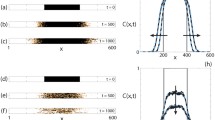Abstract:
A model of herding is introduced which is exceptionally simple, incorporating only two phenomena, growth and addition. At each time step either (i) with probability p the system grows through the introduction of a new agent or (ii) with probability q = 1 - p a free agent already in the system is added at random to a group of size k with rate Ak. Two versions of the model, A k = k and A k = 1, are solved and in both versions we find two different types of behaviour. When p > 1/2 all the moments of the distribution of group sizes are linear in time for large time and the group distribution is power-law. When p < 1/2 the system runs out of free agents in a finite time.
Similar content being viewed by others
Author information
Authors and Affiliations
Additional information
Received 12 February 2002 Published online 9 July 2002
Rights and permissions
About this article
Cite this article
Rodgers, G., Yap, Y. Growth and addition in a herding model. Eur. Phys. J. B 28, 129–132 (2002). https://doi.org/10.1140/epjb/e2002-00209-7
Issue Date:
DOI: https://doi.org/10.1140/epjb/e2002-00209-7



